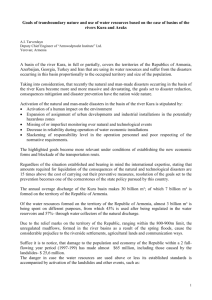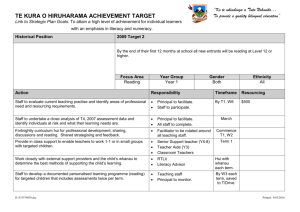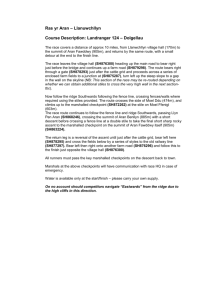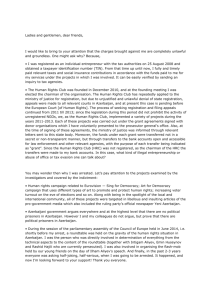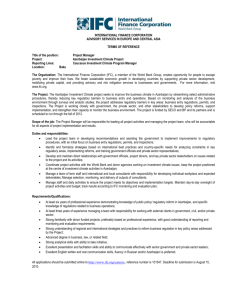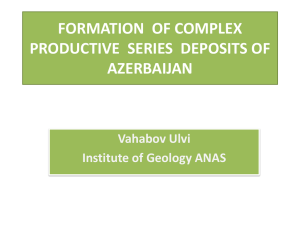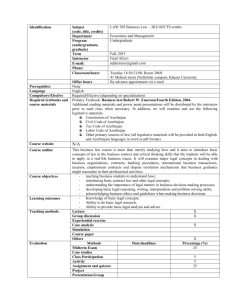Document 10466006
advertisement
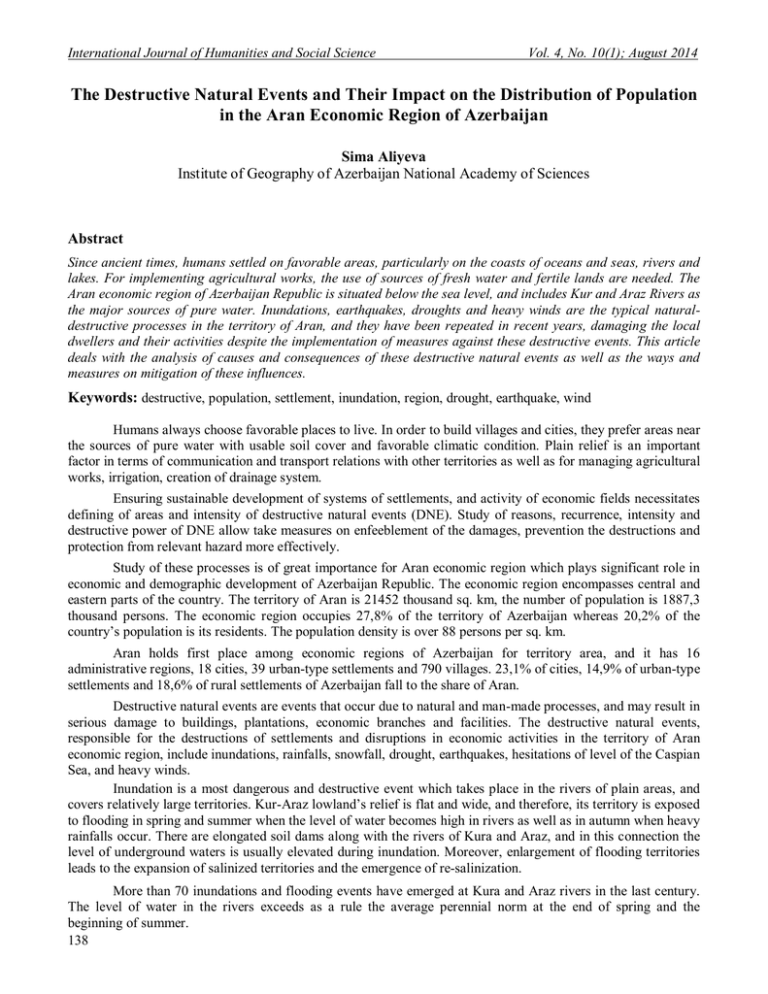
International Journal of Humanities and Social Science Vol. 4, No. 10(1); August 2014 The Destructive Natural Events and Their Impact on the Distribution of Population in the Aran Economic Region of Azerbaijan Sima Aliyeva Institute of Geography of Azerbaijan National Academy of Sciences Abstract Since ancient times, humans settled on favorable areas, particularly on the coasts of oceans and seas, rivers and lakes. For implementing agricultural works, the use of sources of fresh water and fertile lands are needed. The Aran economic region of Azerbaijan Republic is situated below the sea level, and includes Kur and Araz Rivers as the major sources of pure water. Inundations, earthquakes, droughts and heavy winds are the typical naturaldestructive processes in the territory of Aran, and they have been repeated in recent years, damaging the local dwellers and their activities despite the implementation of measures against these destructive events. This article deals with the analysis of causes and consequences of these destructive natural events as well as the ways and measures on mitigation of these influences. Keywords: destructive, population, settlement, inundation, region, drought, earthquake, wind Humans always choose favorable places to live. In order to build villages and cities, they prefer areas near the sources of pure water with usable soil cover and favorable climatic condition. Plain relief is an important factor in terms of communication and transport relations with other territories as well as for managing agricultural works, irrigation, creation of drainage system. Ensuring sustainable development of systems of settlements, and activity of economic fields necessitates defining of areas and intensity of destructive natural events (DNE). Study of reasons, recurrence, intensity and destructive power of DNE allow take measures on enfeeblement of the damages, prevention the destructions and protection from relevant hazard more effectively. Study of these processes is of great importance for Aran economic region which plays significant role in economic and demographic development of Azerbaijan Republic. The economic region encompasses central and eastern parts of the country. The territory of Aran is 21452 thousand sq. km, the number of population is 1887,3 thousand persons. The economic region occupies 27,8% of the territory of Azerbaijan whereas 20,2% of the country’s population is its residents. The population density is over 88 persons per sq. km. Aran holds first place among economic regions of Azerbaijan for territory area, and it has 16 administrative regions, 18 cities, 39 urban-type settlements and 790 villages. 23,1% of cities, 14,9% of urban-type settlements and 18,6% of rural settlements of Azerbaijan fall to the share of Aran. Destructive natural events are events that occur due to natural and man-made processes, and may result in serious damage to buildings, plantations, economic branches and facilities. The destructive natural events, responsible for the destructions of settlements and disruptions in economic activities in the territory of Aran economic region, include inundations, rainfalls, snowfall, drought, earthquakes, hesitations of level of the Caspian Sea, and heavy winds. Inundation is a most dangerous and destructive event which takes place in the rivers of plain areas, and covers relatively large territories. Kur-Araz lowland’s relief is flat and wide, and therefore, its territory is exposed to flooding in spring and summer when the level of water becomes high in rivers as well as in autumn when heavy rainfalls occur. There are elongated soil dams along with the rivers of Kura and Araz, and in this connection the level of underground waters is usually elevated during inundation. Moreover, enlargement of flooding territories leads to the expansion of salinized territories and the emergence of re-salinization. More than 70 inundations and flooding events have emerged at Kura and Araz rivers in the last century. The level of water in the rivers exceeds as a rule the average perennial norm at the end of spring and the beginning of summer. 138 © Center for Promoting Ideas, USA www.ijhssnet.com In some years, inundations may emerge due to higher continuous snowfall, and consequently, accumulation of water reserves and speedy melting of them in the condition of rising air temperature. In the meantime, sharp rise of the level of water may be accelerated under the influence of rainfalls. This process depends significantly on managing the regime of the water reservoirs properly. Thus, level of water in the reservoirs is kept at medium and highest level as usual. In case of heavy downpour, the water is discharged, as a result of which the level of water in Kura River becomes elevated due to accumulation of common waters of melting ice, rainfall and discharged water from reservoirs in a short time. From upper parts of Kura-Araz lowland to the place of conjunction of these two big rivers, the rise of water causes to the emergence of inundation, and the inundated territories becomes larger in lower areas. This process took place in 2003 and 2006. Inundations have taken place regularly in Kura and Araz Rivers since the beginning of 20th century. The creation of system of water reservoir in Kura River has allowed prevent the occurrence of inundation since 50s. However, the increasing economic activity has influenced on the water regime of Kura and Araz. The rise of the water several times resulted in destruction of human settlements, agricultural fields, highways and roads, and facilities of industry and social service. Since the construction of Mingachevir water reservoir the highest flow rate in Kura River has been recorded in 1969 by Surra point (2680 m3/sec). In 2010, the indicator made up 2500 m3/sec. For a long time, it was considered that inundations in Kura and Araz are completely managed, and the relevant threat is curbed due to the functioning of the commissioned water reservoirs on these rivers. However, the climate change and hydrometeorological anomalies may result in unpredictable change by regime of this rivers and occurrence of inundations. Periods of abundant water in Kura and Araz rivers are nearly the same. This factor causes to arising of water mass in large volume during definite part of a year. In this relation, the level of water rises sharply at lower parts of Kura River, and the inundated territories become unfit in large territories. The settlements near Kura and Araz rivers face more threat in connection with increasing intensity of rainfall and snowfall in the areas such as Shirvan, Salyan, Neftchala, Saatly, Sabirabad, Imishli, Zardab. This event have damaged housing buildings, industrial and agricultural facilities, highways, communicational lines, land resources of farming importance. After the construction of Mingachevir water reservoir the highest flow rate in Kura River has been recorded in 1969 by the Surra point (2680 m3/sec). In 2010, the indicator made up 2500 m3/sec. For a long time, it was considered that inundations in Kura and Araz as well as the relevant threat are managed due to the functioning of the commissioned water reservoirs on these rivers. However, in reality it was obvious that the climate change and hydrometeorological anomalies may result in unpredictable change by regime of this rivers and occurrence of inundations. Inundations that took place in spring of 2003, were responsible for the damage on the areas of planting in 17,4 thousand hectare in the administrative regions of Salyan, Neftchala, Saatli, Sabirabad and Hajigabul as well as over 300 settlements, including 5,3 thousand private houses. The total damage made up over 20 million Azerbaijani manat (Maharramova, p. 64). Among the regions, Neftchala faced more damage because it is situated in lower part of Kura-Araz lowland, at the mouth of Kura River. In 2003, 1200 private houses were damaged due to the inundations whereas in 2006, the figure was over 2000 in Neftchala region. In the territory, 120 houses became useless, and 2 thousand hectares of planting areas were flooded (p.65). In 2005, inundation has not been observed due to normal accumulation of water in the Mingachevir Reservoir whereas the next year this natural disaster took place in lower flow Kura River as a result of increasing flow rate. Simultaneously, the highest flow rate (1060 m3/sec) has been fixed at the points near the mouth of Kura. The more destructive inundation in Kura-Araz lowland has taken place on May and June of 2010. As a result of this, at least 8 administrative regions seriously suffered from inundation. Tens of villages in Zardab, Saatli, Sabirabad, Imishli, Neftchala and other regions, including the cities-administrative centers as well as Shirvan city faced with destructive power of water. The local population was obliged to migrate from their permanent places of living. 139 International Journal of Humanities and Social Science Vol. 4, No. 10(1); August 2014 Domestic animals were killed in a number of settlements. Hundreds of hectares of lands of agricultural importance were inundated. Industrial objects of social infrastructure, highways and other transportation facilities were destructed or seriously damaged. Inundations have been occurring over and over in the basin of Kura and Araz Rivers. This territory is considered as one of ancient places of habitation of humans and the development of planting. However, substantial measures against inundations have not been implemented in this territory. Technological and hydrotechnical ways of preventing this natural disaster also were not carried out and in this connection, most of settlements has been created far from the rivers. In the meantime, waters of the river were accumulated to special lower and depressive areas during definite seasons for irrigation purposes. These ancient depressive areas as remnants of such activity are still observed in form of gully near lower reaches of Kura River. The resettlement of Russians in Kura-Araz lowland, particularly in Mugan Plain in the second half of 19th century, and the creation of large network of channels of irrigation caused to arising of settlements of larger size on the banks of Kura and Araz. Definite measures on protecting settlements from inundations were implemented in this period, but they were not allowing curb this destructive process completely. Even in 1896, inundations that occurred in Araz were so hard that the river restored its previous bed in Mugan Plain and restarted to flow directly into the Caspian Sea as before (p/20). Since the beginning of 20th century, the length of land-protecting dams on the banks of rivers was increased. Starting from the 20-30s of the 20th century, the economy of Azerbaijan has been developed in peaceful condition. In the Soviet period, the creation and development of cities and villages and the establishment of processing enterprises necessitated extending of used territories. The last process was conducted without taking into consideration the up-rise of water, and the land resources near banks of rivers have been attracted to production in many places of Aran region. In such condition, settlements and facilities had been suffering from influence of inundations. After World War II economic advancements required the solution of environmental problems, including protection from flooding. In 1953, Mingachevir – the largest reservoir in South Caucasus were commissioned. This event made possible to regulate the level of water in Kura, produce cheap electric energy, wash and irrigate hundreds of thousands of salinized areas in Kura-Araz Lowland. Further the two irrigating channels called Yukhari Garadagh and Yukhari Shirvan and a number of water reservoirs such as “Araz Water Junction” (1970) and Bahramtapa Water Junction on Araz River as well as Shamkir (1982) and “Yenikand” (2000) on Kura River were constructed and commissioned. Besides inundation, drought also is the origin of threat for economic activity in Azerbaijan, especially in Aran region. This dangerous atmospheric process negatively influences on the use of land resources, the farming businesses and the gathering of agricultural yields. Drought may occur in Aran region relatively long time where arid condition is dominant and semi-deserts are widespread. Drought may prevail in spring and/or summer, and is characterized with very dry and hot condition. It is characterized also with too less precipitation in the central part of the country. Droughts are responsible for decrease in fertility of soils and productivity of agricultural production. The noted problems are typical for Aran as well. Relevant defensive measures include the planting of special field-protecting green margins, the creation of man-made irrigating systems, and the storing of snow. Earthquake is another destructive and natural, and the same time practically unpredictable event which may occur in the territory of Aran economic region. Despite that Azerbaijan is situated in Alpine-Himalayan geosynclinal belt, the Aran region is included into zones with relatively low seismicity. However, earthquakes were responsible for destructions and challenges that private buildings, infrastructure facilities and industrial fields have experienced in this territory. Seismicity of the territory of Aran is considered to be 7 points, and numerous earthquakes have taken place here, including in 1985 and 1989 (Imishli, 5 points), 1999 (Agdash, 5 points), 2003 (Mingachevir, 4 points), and 2014 (Hajigabul). In this connection, additional technical measures are to be implemented, and the bases of buildings are to be fastened when constructing new objects and facilities. Winds considerably affect the climatic condition of the territory of Aran. Geographically, the region is covered by mountains and the Caspian Sea to the east. The differences and change by temperature and atmospheric pressure lead to the occurrence of winds. In previous years, heavy winds were responsible for the damage caused to economic facilities, private houses, enterprises of power industry, etc. 140 © Center for Promoting Ideas, USA www.ijhssnet.com Winds may turn to destructive power if their speed exceed 25-30 m/sec. The studies show that the number of such windy days makes up 10-15 days a year in the Aran region. Mingachevir city, Kurdamir and Neftchala regions are the areas where winds occur more (up to 37-40 days a year). In Azerbaijan, hot and dry winds occurring on warm season usually bring sandy air from the south and the south-east. This windy air masses create sandy storms, and entail higher temperature of the air. Sometimes these winds may invade the airspace of Azerbaijan also from the east via the territory of the Caspian Sea. In such cases, the concentration of sand in the air may increase, and this affect human health. This condition may also result in soil erosion, losses in agriculture, falling productivity in spring, and also drought. Such winds called among the people Ag Yel (White Wind) and Gara Yel (Black Wind) are typical for the territory of Aran. The planting of special green strips is advisable as the defensive measure against dry winds. References Babakhanov, N.A. (2006). Is it possible to curb natural disasters? Baku. Babakhanov, N.A., Pashayev N.A. (2004). Economic and social-geographic study of natural disasters. Baku. Maharramova Kh., J. (2008). Destructive hydrometeorological events occurring in the territory of Azerbaijan. Mahmudov, R. (2014). Dangerous hydrometeorological events in Azerbaijan. Baku. Demographic indicators of Azerbaijan – 2011. (2012). Yearly bulletin of State Statistical Committee of Azerbaijan Republic. Baku. Regions of Azerbaijan – 2010. (2011). Yearly bulletin of State Statistical Committee of Azerbaijan Republic. Baku. Statistic indicators of Azerbaijan – 2010. (2011). Yearly bulletin of State Statistical Committee of Azerbaijan Republic. Baku. 141
